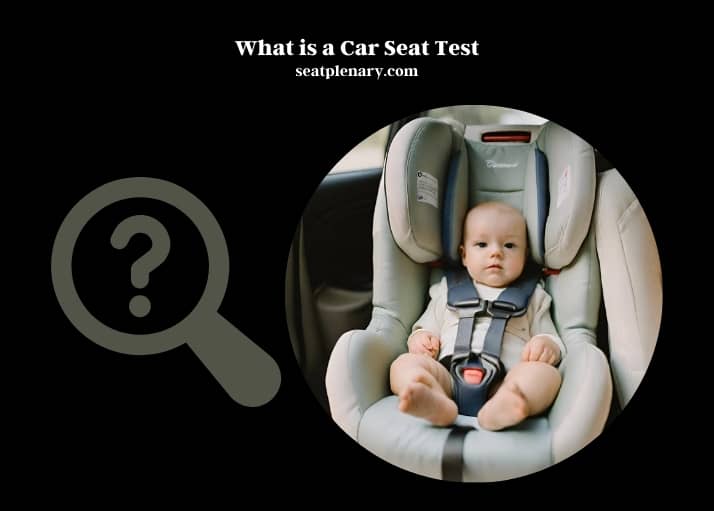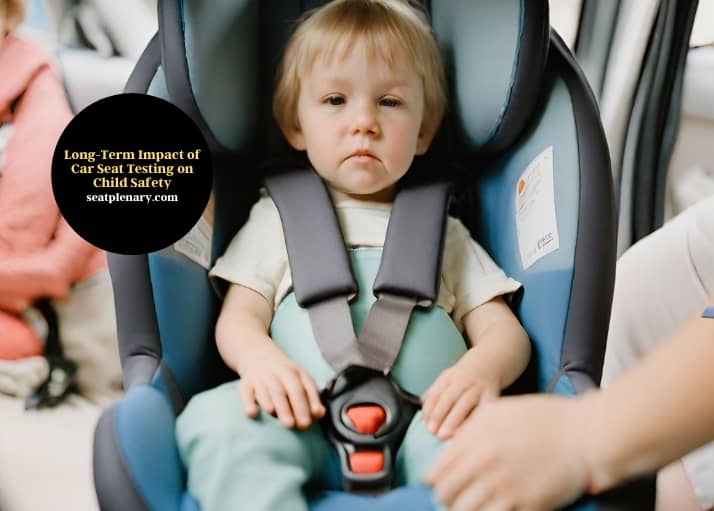A car seat test is an evaluation to ensure that an infant or child can safely travel in a car seat. It typically involves monitoring the child’s breathing and positioning in the seat over a period.
Car seat tests are crucial for infant safety, particularly for newborns and premature babies. Hospitals often conduct these tests before discharging a newborn, ensuring that the baby can maintain a safe and comfortable position in the car seat, without any respiratory issues. The test usually lasts for the duration of an average car trip, allowing healthcare professionals to assess the baby’s ability to handle the journey. For premature or low-birth-weight babies, the test is even more critical due to their increased vulnerability.
These infants might require a longer testing period or special car beds designed for their safety. Parents are also encouraged to learn how to properly install car seats and position their child, although this does not replace the comprehensive hospital test. Regularly conducting these tests as the child grows is vital, as it ensures the car seat continues to provide adequate protection through different stages of the child’s development.

Key Elements of Car Seat Testing
Car seat tests are critical for ensuring the safety of infants during travel. These tests are designed to assess various aspects of a car seat’s performance, including adherence to safety standards and suitability for different infant weights. Hospitals often use these tests to determine if a newborn is ready for discharge, ensuring the car seat can safely support the baby during travel.
A crucial part of the test involves measuring the recline angle of the seat to prevent the infant’s head from falling forward, which can obstruct breathing. The duration of the test is also significant, as it must be long enough to simulate a real journey, typically around 90 minutes. This comprehensive evaluation ensures that the car seat meets all necessary safety criteria before it is used for an infant.
Car Seat Tests and Infant Safety
Car seat tests play a pivotal role in safeguarding infants during vehicle transportation. These tests focus on several key areas, including the car seat’s ability to enhance accident survival rates and prevent injuries. Proper harness usage is scrutinized to ensure that the straps are neither too loose nor too tight, providing optimal protection without causing discomfort to the infant.
Head support and side-impact protection are also evaluated, as these are crucial for preventing serious head and neck injuries in the event of a collision. By rigorously testing these elements, car seat tests contribute significantly to reducing the risk of injury for infants in automobiles.
Comparing Car Seat Models
When selecting a car seat, parents often face a myriad of choices. This section provides a comparative analysis of various car seat models, considering factors like brand reputation, user reviews, safety ratings, pricing, and ease of installation. The comparison aims to help parents make informed decisions based on a balance of safety, affordability, and user-friendliness.
Comparison of Top Car Seat Models Based on Safety Ratings and Features
| Brand | Model | Safety Rating (NHTSA) | Price Range | Installation Ease | User-Friendly Features | User Rating |
| SafeJourney | Alpha Elite | 5 Stars | $$$ | Easy | Adjustable headrest, LATCH system | 4.6/5 |
| SecureRide | Guardian Pro | 4 Stars | $$ | Moderate | Side-impact protection, machine washable cover | 4.3/5 |
| ComfortCradle | Harmony Deluxe | 5 Stars | $$$$ | Easy | Recline adjustment, integrated cup holders | 4.8/5 |
| BabyGuard | Everest 360 | 4 Stars | $$$ | Challenging | Extended weight limit, energy-absorbing foam | 4.2/5 |
| TravelTot | SafeNest | 5 Stars | $$ | Easy | Compact design, FAA approved for air travel | 4.7/5 |
Conducting a Car Seat Test: A Step-by-Step Guide
Conducting a car seat test involves a detailed procedure that must be followed meticulously to ensure accuracy and safety. Hospitals typically have specific protocols for these tests, which parents should be familiar with. Preparation is key, and parents should be informed about how to properly install the seat and position their infant.
The test includes monitoring the baby’s response, such as breathing and comfort, over a set period. Awareness of common errors, such as incorrect seat angle or loose harnesses, is crucial for a successful test. This guide aims to equip parents with the knowledge needed to confidently conduct a car seat test.
Long-Term Impact of Car Seat Testing on Child Safety
The long-term impact of car seat testing on a child’s safety extends beyond the immediate infancy stage. These tests play a vital role in ensuring that the car seat supports the child’s developmental needs, providing adequate posture support and contributing to spinal health. As children grow, the transition from car seats to booster seats is another critical phase where safety tests are essential.

Child Safety in Car Accidents with and without Proper Car Seat Usage
| Age Group | With Car Seat (%) | Without Car Seat (%) |
| 0-2 years | 90% injury-free | 50% injury-free |
| 3-5 years | 85% injury-free | 40% injury-free |
FAQs
Is a Car Seat Test Mandatory for Newborns?
In many hospitals, a car seat test is a mandatory procedure for newborns before they are discharged. This test ensures that the infant can safely travel in a car seat, particularly focusing on their ability to breathe properly and maintain a safe position.
During the test, the baby is placed in the car seat for a period, typically around 90 minutes, to monitor their oxygen levels and overall comfort. The test’s primary goal is to identify any potential issues that could arise while the baby is in the car seat, such as respiratory problems or physical distress.
What Happens During a Car Seat Test?
During a car seat test, several key factors are monitored to ensure the infant’s safety. The baby is placed in the car seat, just as they would be for a journey. Medical staff then observe the baby, checking for any signs of distress, difficulty breathing, or changes in oxygen levels.
The baby’s posture is also assessed to ensure there is no slumping that could lead to breathing difficulties. The test usually lasts for the duration of a typical car trip, allowing caregivers to confidently assess the baby’s ability to handle car travel.
How Does a Car Seat Test Relate to the Design of Honda Fit Seat Backs with Zippers?
The design of Honda Fit seat backs with zippers is crucial to passing a car seat test. The zippers must be durable and secure to ensure the safety of passengers. Honda takes the design and function of these zippers very seriously, as they are vital for passing safety tests. honda fit seat zippers explained.
Can Parents Conduct a Car Seat Test at Home?
While hospitals have specific protocols for car seat tests, parents can also conduct basic checks at home. It involves ensuring the car seat is properly installed, the baby is correctly positioned, and the harness is snug and secure. Parents should observe their baby in the car seat, looking for any signs of discomfort or breathing difficulties. However, this home check does not replace the comprehensive test conducted in hospitals, which is designed to rigorously assess the baby’s safety in the car seat.
What Are the Criteria for Passing a Car Seat Test?
To pass a car seat test, the infant must remain stable and comfortable throughout the test duration. Key criteria include maintaining steady oxygen levels, showing no signs of respiratory distress, and being able to tolerate the semi-upright position of the car seat without any issues.
The baby’s heart rate and color are also monitored. If the infant exhibits any signs of distress or if their oxygen levels drop, they may not pass the test, indicating a need for further evaluation or a different car seat.
How Do Car Seat Tests Differ for Premature Infants?
Car seat tests for premature infants often require extra attention due to their increased vulnerability. Premature babies might have more difficulty maintaining a safe position in the car seat and are more prone to episodes of apnea or bradycardia.
The test for a premature infant might be longer, and the criteria for passing can be stricter. In some cases, a specialized car bed may be recommended if the infant cannot safely sit in a standard car seat.
Are There Different Types of Car Seat Tests?
There are different types of car seat tests, primarily varying based on the age and size of the child. For newborns and very young infants, the test focuses on issues like breathing and head control. As children grow, the emphasis shifts to the proper fit of the harness and the seat’s alignment with the child’s height and weight.
Convertible car seats and booster seats have their own specific tests to ensure they provide adequate protection as the child grows.
Summary
Car seat tests are an indispensable aspect of infant safety in vehicles. From ensuring compliance with safety standards to evaluating long-term impacts on child safety, these tests provide a comprehensive assessment of a car seat’s effectiveness. The comparative analysis of different models and detailed guidelines for conducting tests further aid parents in making informed decisions.
Ultimately, the rigorous testing of car seats plays a crucial role in safeguarding our youngest passengers on every journey.
